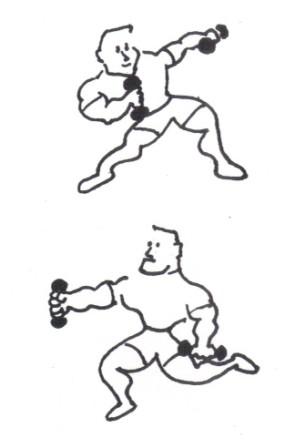Longstrength, Peak Power: Warming Up Chapter 3
by John McKean
Chapter 3 – Longstrength
Although I enjoy playing around with differing Heavyhands combinations from time to time, and like Heavyhands walking with my wife during off days (active rest for recuperation), my favorite training warmup is known as “shadowboxing.”
As the name implies, a free sparring session is done with weighed hands (2-1/2 pound plates work as well as anything). Just stalk around the gym after an invisible adversary, punching quickly with all manner of improvised blows, body weaves, and footwork combinations. Have fun with it, let your imagination and energy flow, and beat up the bad guy for 15-20 minutes. After winning this match (it’s so easy when no one’s hitting back), you’ll feel mentally and physically aggressive enough to attack a heavy barbell immediately. What formerly was a weight that required 5 sets to even think about, you’ll feel like biting in half.
After complete satisfaction for several years, I sure thought Heavyhands shadowboxing was the last word in preparation for weight training. Then Dr. Schwartz exposed me to another dimension—an aerobic warmup that could actually add strength and muscularity. Always interested in my application to weight training of his concepts, the good doctor regularly supplements my gym findings with related laboratory research and his own considerable knowledge of exercise and the body. But I was left speechless the day he phoned to announce that he’d just completed 750 (not a misprint—seven hundred and fifty) chin-ups! Now, I know his own daily Heavyhands workouts have given him superb conditioning and, despite being 68 years of age, the sleek, refined look of a “natural” physique contender (my wife calls him the ultimate hunk!) But even this amazing aerobic athlete surely could not perform 75 times the number of chins most of us strain to do. Then he told me about Longstrength…
Before describing Longstrength, however, let’s take care of your curiosity as to exactly how this past-prime-time superman managed his “impossible” chin-ups. By the way, since then, Schwartz has specialized on alternate one arm chins and recently hit a personal high of 2,000 (yes, two thousand!) performed continuously for 45 minutes. What’s the trick? Well, in his usual quest to employ as many muscles as possible during exercise, Schwartz simply combined a chin-up with a free squat. That is, he set up a bar at about standing chin height, then squatted down until arms were extended fully, and pulled back up with combined bicep, lat and leg power. (Often he pressed up while descending to also involve the delts and triceps.) In this innovative maneuver, arm power “lightens” the body, enabling far more free squats than ever possible, while leg thrust during the up stroke allows chin-up repetitions previously capable only by the “Energizer Bunny”—it can keep on going, and going, and going…
Longstrength, then, seeks the integration of many muscle groups at once in unique combinations of pushes and pulls which involve one’s own artificially lightened bodyweight as resistance. Its goal is to marry strength with endurance to, as Schwartz described, “lasso all your muscles and more in a loop of total fitness.” Naturally, a Longstrength devotee will, in short order, hit hundreds of reps per exercise (better measured in minutes than by counting reps) to effectively engage the cardiovascular system.
To date, Dr. Schwartz has created over 100 Longstrength exercises, and a new book describing this astounding fitness strategy is due out in early 1994. Careful experiments have flabbergasted researchers when subjects generated unexpected high levels of oxygen uptake (a prime measure of aerobic effectiveness) on these relatively slow-paced moves. Yet due to “muscle loading”—a simultaneous involvement of most of the body’s musculature—subjects reported feeling far less of an effort than computer read-outs showed their workload to be.
During the past two years, Longstrength has become the core of my entire lifting program. It compliments my initial shadowboxing warmup (which Schwartz considers part of Longstrength anyway) by nudging the large muscle groups of the legs, hips and back into play without tiring me prior to lifting. Virtually every inch of my body is readied for applying peak power, with the new combined exercises also adding a unique means of building explosiveness safely and, by its very nature, offering some mild preparatory stretching. Surprisingly, I’ve noticed vastly improved muscularity in my arms, delts, lats and thighs. Most importantly though, since strength-orientated moves such as pull-ups, dips, squats and bend-overs are the basis of Schwartz’s new regimen, gains in my all-round competitive lifts have accelerated significantly.
A few words of caution. While Longstrength offers us iron hefters two factors we’re very familiar with and always relish, namely, endless variety and limitless, rapid progression, please don’t ever stray from the muscle-loading concept—strive always to use as many muscles as possible in any unique combination which you’re sure to invent. If you confuse this with any form of “circuit training,” where many muscle groups are attempted to be reached by moving from one isolation exercise to another, none of the benefits above will be achieved. In fact, when carefully analyzed, the once highly-touted circuit training proved to do absolutely nothing toward increasing aerobic capacity—measured oxygen utilization actually was quite low despite all the huffing and puffing between stations. So, although circuits did hit a variety of exercises and created rapid heart rates, they were exposed as a complete bust for endurance, never produced much strength or development, and served just to tire trainees needlessly. Remember, we want to warm up without burning out.
